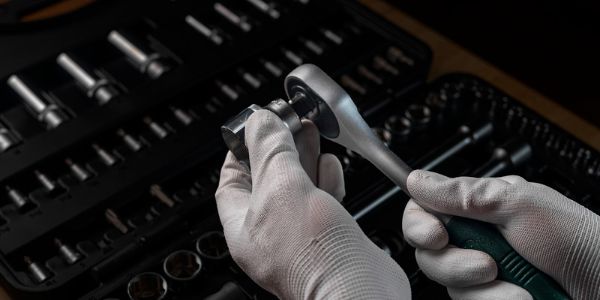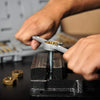
The Must-Have DIY Ratchet and Socket Accessories
DIY enthusiasts, handymen, and professionals alike know the importance of having a well-equipped toolbox. The right tools make all the difference in completing a project efficiently and effectively. One set of tools that should never be underestimated is the ratchet and socket set.
In this comprehensive guide, we will delve into the must-have ratchet and socket accessories for your DIY projects, providing you with valuable information on their uses, benefits, and maintenance tips.
Related Article: Different Types of Rachets and Sockets
Table of Contents
- Socket Sets: The Basics
-
Must-Have Accessories
- Extension Bars
- Universal Joints
- Socket Adapters
- Impact Sockets
- Spark Plug Sockets
- Crowfoot Wrenches
- Torque Wrenches
- Speciality Sockets
-
Breaker Bars
-
Conclusion
Socket Sets: The Basics
Before diving into the must-have ratchet and socket accessories, let's first discuss the basics of socket sets. Socket sets typically include a ratchet handle, various sizes of sockets (measured in either metric or imperial units), and sometimes additional accessories. These tools are essential for loosening and tightening nuts and bolts in various DIY projects.
The primary components of a socket set are:
- Ratchet: A ratchet handle allows you to tighten or loosen a nut or bolt by turning the handle in one direction, while the ratcheting mechanism prevents it from rotating in the opposite direction. This enables you to work in tight spaces without having to remove and reposition the socket on the fastener constantly. Ratchet handles come in various drive sizes, such as 1/4-inch, 3/8-inch, and 1/2-inch, which determine the size of the square-shaped connection point for sockets and accessories.
- Sockets: Sockets are cylindrical metal pieces with a hexagonal (six-sided) opening at one end that fits onto a nut or bolt head. The other end of the socket has a square-shaped hole that connects to the ratchet handle or other accessories. Sockets come in various sizes, measured in either metric (millimeters) or imperial (inches) units. They can also be classified as "deep" or "shallow" based on their depth, with deep sockets being more suitable for use on longer fasteners or in recessed areas.
Now that we have covered the basics let's explore the must-have ratchet and socket accessories.
Related Article: Tips for Maintaining Your DIY Rachets and Sockets
Must-Have Accessories
Extension Bars
An extension bar is a long, straight metal rod with a square-shaped hole at one end and a square-shaped protrusion at the other. It connects between the ratchet handle and the socket, allowing you to reach nuts and bolts that are located in deep or hard-to-reach areas. Extension bars come in various lengths, typically ranging from 2 inches to 24 inches. A good set of extension bars should include:
- Short (2-4 inches): Ideal for reaching slightly recessed fasteners.
- Medium (6-10 inches): Suitable for reaching moderately recessed fasteners or working in tight spaces.
- Long (12-24 inches): Perfect for accessing deeply recessed fasteners or working in very tight spaces.
When working with extension bars, it's essential to ensure that the bar is securely connected to both the ratchet handle and the socket. This prevents accidental disconnection during use, which can lead to dropped sockets or damage to the fastener.
Universal Joints
A universal joint is a small, hinged accessory that connects between the ratchet handle and the socket. It allows the socket to pivot and rotate at various angles, providing greater flexibility when working in tight or awkward spaces. Universal joints are especially useful when trying to reach fasteners located behind obstacles or around corners.
To use a universal joint effectively, connect it between the ratchet handle and the socket, then position the socket onto the fastener. Apply pressure to the ratchet handle while maintaining the desired angle, allowing the joint to pivot as needed. Keep in mind that universal joints may reduce the amount of torque you can apply to a fastener, so they may not be suitable for extremely tight or stubborn bolts.
Socket Adapters
Socket adapters are small metal pieces that enable you to use sockets with different drive sizes on the same ratchet handle. They have a square-shaped hole at one end and a square-shaped protrusion at the other end, with each end having a different size. For example, a 1/4-inch to 3/8-inch adapter allows you to use a 3/8-inch socket on a 1/4-inch ratchet handle. Socket adapters are essential for maximizing the versatility of your ratchet and socket set.
In addition to the standard socket adapters, there are also impact-rated adapters designed for use with impact wrenches or drivers. These adapters are made from more durable materials to withstand the high torque and vibration produced by impact tools.
Impact Sockets
Impact sockets are specifically designed for use with impact wrenches or drivers, which generate high amounts of torque and vibration. These sockets are typically made of thicker, more durable material (usually chrome-molybdenum steel) than standard sockets, making them less likely to crack or break under heavy loads. Impact sockets are often black in color and have a slightly larger outer diameter than regular sockets.
When using impact sockets, it's essential to ensure that they are compatible with your impact tool's drive size and designed for the type of fasteners you are working with. It's also crucial to wear appropriate safety gear, such as eye protection and gloves, as the high torque generated by impact tools can cause debris to fly off during use.
Spark Plug Sockets
Spark plug sockets are specialized sockets designed specifically for removing and installing spark plugs in engines. They have a rubber or foam insert inside the socket's hexagonal end, which grips the spark plug's insulator and prevents it from slipping or getting damaged during removal or installation.
Spark plug sockets typically come in two common sizes: 5/8-inch and 13/16-inch, although other sizes may be required for specific applications.
When using a spark plug socket, ensure that the socket is securely connected to the ratchet handle or extension bar, and that the rubber or foam insert is in good condition. Apply steady pressure while turning the ratchet handle, avoiding excessive force that could damage the spark plug or its threads.
Crowfoot Wrenches
Crowfoot wrenches are open-ended wrenches with a square-shaped hole at one end that connects to a ratchet handle or extension bar. They allow you to apply torque to a fastener using a ratchet handle while providing the accessibility of an open-ended wrench.
Crowfoot wrenches are especially useful for reaching fasteners located in tight spaces where a regular socket or wrench cannot fit.
When using a crowfoot wrench, ensure that it is securely connected to the ratchet handle or extension bar and positioned correctly on the fastener. Apply steady pressure to the ratchet handle while maintaining the proper angle for the wrench, avoiding slippage or damage to the fastener.
Torque Wrenches
A torque wrench is a specialized tool that allows you to apply a precise amount of torque (turning force) to a fastener, ensuring that it is tightened to the manufacturer's specifications.
This is particularly important in applications where over-tightening or under-tightening can cause damage or compromise the structural integrity of the assembly (e.g., automotive, aerospace, and machinery). Torque wrenches typically have a ratchet mechanism and can be used with regular sockets.
When using a torque wrench, it's crucial to consult the manufacturer's specifications for the correct torque values and follow the instructions provided with your torque wrench to ensure accurate readings. Once the desired torque value is achieved, stop applying force to avoid over-tightening the fastener.
Speciality Sockets
Speciality sockets are designed for specific tasks or unique fasteners that standard sockets cannot accommodate. Some examples of specialty sockets include:
- Axle nut sockets: These large sockets are designed for removing and installing axle nuts on various vehicles.
- E-Torx sockets: These sockets have a star-shaped opening to accommodate E-Torx (external Torx) fasteners, which are commonly found in automotive and electronics applications.
- Oil filter sockets: These sockets have a custom shape to fit the grooves and notches on oil filters, allowing for easier removal and installation.
When using specialty sockets, ensure that they are compatible with the fastener you are working with and securely connected to the appropriate ratchet handle or extension bar.
Breaker Bars
A breaker bar is a long, non-ratcheting handle with a square-shaped connection point for sockets or other accessories. Breaker bars are designed for applying significant amounts of torque to break loose stubborn or rusted fasteners. Because they lack a ratcheting mechanism, breaker bars can handle more force than a standard ratchet handle without the risk of damaging the internal components.
When using a breaker bar, ensure that it is securely connected to the appropriate socket or accessory and positioned correctly on the fastener. Apply steady, even pressure to the breaker bar handle, using your body weight if necessary to generate the required torque.
Be cautious of potential slippage or sudden movements when the fastener breaks loose, as this can cause injury or damage to the surrounding components.
Related Article: Basic Tools and Toolkits For Car Maintenance
Conclusion
Having the right ratchet and socket accessories can make all the difference in your DIY projects. By investing in the best items and with proper organization and maintenance, you'll be well-equipped to tackle any project with confidence and ease.
Remember that quality matters when it comes to these essential tools, so it’s best to purchase reputable brands to ensure long-lasting performance and reliability.



